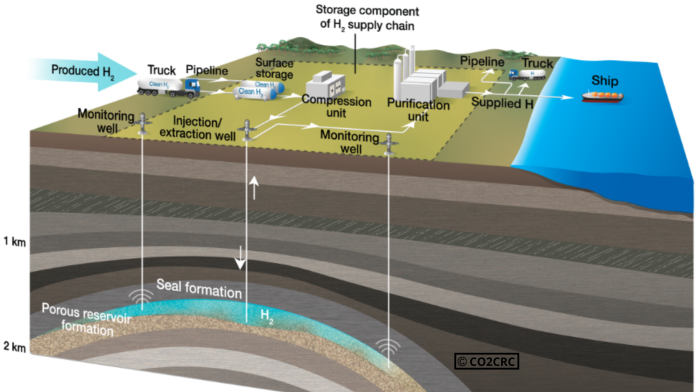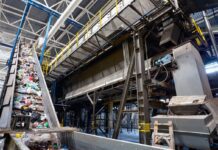
Media Release By CO2CRC
CO2CRC, along with its key research partners – CSIRO and Geoscience Australia, are collaborating on pioneering research into the technical development of geological storage of hydrogen in Australia.
The hydrogen industry in Australia is expected to increase 40% by 2030 with potential export values of $5.7billion by 2040. To facilitate a hydrogen supply chain greater than 100,000 tonnes of scale required for a net-zero future and export market, hydrogen must be stored in geological formations.
Underground Hydrogen Storage (UHS) provides the much-needed capacity to balance supply and demand and seasonal fluctuations. Current surface hydrogen storage facilities, such as pipelines or tanks will not have the sufficient storage capacity for future projected demand. The value of UHS is that hydrogen can be generated outside of peak demand, stored safely underground until required, providing long term energy security and supply reliability. UHS is therefore an integral link to a commercially effective hydrogen value chain.
“Australia has the technical knowledge and natural resources to become a global leader in hydrogen production and export. Key to the successful implementation of a full-scale hydrogen economy requires large-scale storage, and geological formations present an ideal solution. This Underground Hydrogen Storage Project will fortify Australia’s position as a technical leader in the global transition to a hydrogen economy and net-zero future.” said Dr Matthias Raab, Chief Executive, CO2CRC.
The initial UHS study, co-led by CO2CRC and CSIRO, is aiming to answer key technical issues, including fundamental hydrogen storage processes, hydrogen withdrawal effectiveness and integration of UHS between hydrogen production and downstream distribution. This study is funded by Beyond H2, a foundation member of the NERA Clayton Hydrogen Technology Cluster, pursuing energy-efficient technologies to accelerate the development of Australia’s hydrogen economy.
“Australia has vast porous geological storage resources that are proven storage formations for methane and CO2. These same underground storage formations can provide large-scale and long-term hydrogen storage options to enable Australia to become a leading global exporter of hydrogen. CO2CRC’s pioneering research into underground hydrogen storage in Australia will be fundamental in the development of Australia’s hydrogen economy” says Dr Max Watson, Senior Manager Technology Development, CO2CRC.
The project will develop a clear pathway for a field demonstration of underground hydrogen storage. The study will produce an optimised hydrogen storage site development methodology, with methods to screen, select, develop, and operate suitable hydrogen storage sites at commercial scale. This pre-feasibility study aims to set the foundations for a hydrogen facility demonstration that will safely store and withdraw hydrogen from a geological storage reservoir.
“Underground storage allows large volumes of hydrogen to be stored to manage seasonal variation in demand. Subsurface storage is potentially a safer, lower cost option to surface storage, making use of Australia’s existing geological formations.” said Ms Allison Hortle, Research Group Leader, CSIRO.
Image Credit: http://co2crc.com.au




















